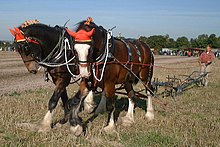Shire Horse
| Shire Horse | |
|---|---|

|
|
| Important data | |
| Origin: | Great Britain, 18th century |
| Main breeding area: | England , Germany |
| Distribution: | Netherlands, Canada, USA, South Africa, Australia, Japan, England |
| Stick measure : | Stallions at least 168 cm, mares at least 163 cm |
| Colors : | Bay, black horse, gray horse, chestnut (not permitted for stallions), each with minimal Sabino markings |
| Main application area: | Draft, riding and show horse, agricultural work, carriage horse |
The Shire Horse is a draft horse and with a maximum mass of more than 1200 kg and an average height of 1.78 m at the withers, it is the largest horse breed in the world.
Background information on horse evaluation and breeding can be found under: Exterior , interior and horse breeding .
Exterior
For the Shires, the height required by the breeding goal is 168 cm for stallions and geldings, and 163 cm for mares . The largest Shire Horse in the world was the gelding Sampson with a height of 2.19 meters in the middle of the 19th century. The Australian stallion Noddy has a shoulder height of 2.05 meters and weighs 1500 kg.
The most common coat color is brown, especially dark brown, followed by black horses , gray horses and the relatively rare foxes . The distinctive markings on the head and legs are typical of the Shire Horse. But there are also white spots in the abdominal area.
interior
The Shire Horse is also called the "Gentle Giant" among the cold-blooded horses. Its gentle character is characteristic. The Shire Horse is capable of learning and has strong nerves.
Breeding history
Originally bred as a knight's horse, it later found its actual use in agriculture or as a carriage horse in front of the wagons of the English breweries. In the 18th century, the farmer Robert Bakewell, known for his successful breeding, developed the Improved Black Cart horse , also called Bakewell Black . Today's Shire Horse was born from this breed. Shires can be found in many emblems or logos of various English pubs and breweries.

While their demise appeared to be sealed in the 1960s , many rural breeders and especially the breweries tried to preserve these mighty horses. In the meantime a show scene has been established that shows the Shire Horse at breeding and performance shows.
use
Like the Clydesdales, Shire Horses are late developers. Due to the rapid growth in the first few years, the bones, cartilage and joints only really grew together late. The horses should only be prepared for work when they are around four years old. Before the development of motorized vehicles , the Shire Horse was used as a draft animal in agriculture, trade, and transportation. In the era of horse trams, the London tram was also popular . Otherwise, however, it has lost its importance as a draft horse and is only harnessed to the brewery or tourist car for advertising purposes . Shire Horses, however, again increased as skidding horses used because they cause far less damage to the forest floor as a modern machine.
See also
literature
- Alberto Soldi: The great nature guide - horses . Kaiser Verlag, Klagenfurt 2003, ISBN 3-7043-1365-3 .
Individual evidence
- ↑ Breeding standard ( Memento of the original from October 7, 2011 in the Internet Archive ) Info: The archive link has been inserted automatically and has not yet been checked. Please check the original and archive link according to the instructions and then remove this notice.
- ↑ a b German Shire Horse Association e. V. German Shire Horse Society: Breed standard ( Memento of the original from February 7, 2013 in the Internet Archive ) Info: The archive link was inserted automatically and has not yet been checked. Please check the original and archive link according to the instructions and then remove this notice.
- ↑ hut / dpa: Shire stallion. The giant horse Noddy is causing a stir in Australia. SpiegelOnline March 15, 2010, 2:40 p.m.
- ↑ Swinney, Nicola Jane: Horse Breeds of the World . Globe Pequot, 2006, ISBN 1-59228-990-8 , p. 178.

